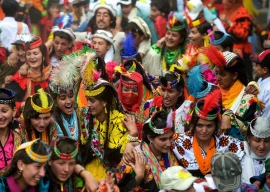
Few Pakistanis would be aware that culturally diverse Brazil has embraced 1.5 million Muslims who have in turn left their mark on the Latin American country’s architecture. In this vein, the Embassy of Brazil launched “Islam in Brazil” --- a photographic exhibition celebrating Muslim life and culture, in collaboration with the National University of Sciences and Technology on Thursday.
Brazilian photographers, Thomaz Napoleão and Helena Jornada have used their lens to explore traces of Muslim culture in the ethnically diverse landscape of Brazil, emphasising largely on the coexistence of modernity and religious values within folds of Brazilian society. The images exude a sense of warmth and assimilation, triggering both human interest and architectural wonder, through portraits, details and interior glimpses of populated mosques.

In the photographs, an advertisement for women endorses decent but chic western wear through beaming models in fashionable hijabs, a cleric leads the Friday prayers at a mosque in the metropolitan Porto Alegre in the southern strip of Brazil and men in T-shirts and jeans congregate for prayers in a sun-lit room without embellishment. In this way, the images convey a Brazilian acceptance towards all faiths and a willingness to absorb diverging cultures.
Sehrish, a third-year architecture student at NUST’s School for Art and Architecture was surprised to learn that some of Brazil’s architecture relayed Muslim influences.

“We only imagine places that are predominantly Muslim or have a rich historical melee with Islam to have such grand mosques,” she expressed.
According to Ambassador of Brazil Alfredo Leoni, the exhibition aims to change such preconceived notions of Pakistanis, whose exposure to the imagery could help relate the commonalities between Brazil and Pakistan.
The number of Muslims, who are concentrated within the Southeast and Southern regions of the country in the heart of Sao Paulo, Rio de Janeiro, the bordering strips of Paraguay and Argentina as well as Porto Alegre, have risen by 29.1 per cent in the last decade. A large portion Arabs from Lebanon, Syria and Palestine make up the Muslim population, though historically Brazil’s first Muslims came from Africa.
The photographs are on display at the School of Art, Design and Architecture at NUST in Sector H-12 till November 28 and are a must-see for those curious about Brazil’s diverse heritage.
Published in The Express Tribune, November 22nd, 2013.























COMMENTS
Comments are moderated and generally will be posted if they are on-topic and not abusive.
For more information, please see our Comments FAQ